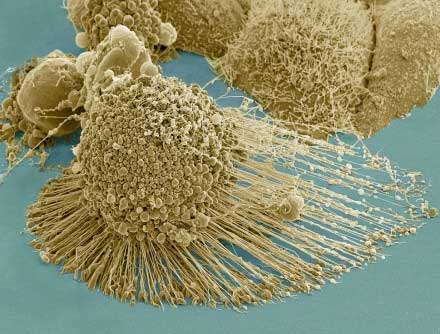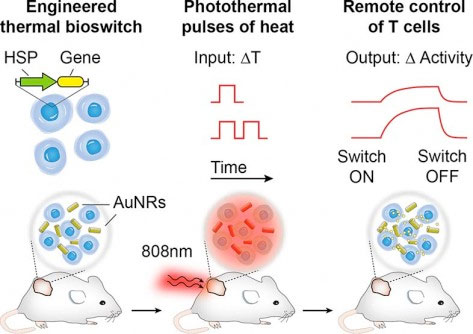| Posted: Apr 20, 2018 |
Remote-control shoots laser at gold to switch on cancer-killing immune cells
(Nanowerk News) A remote command could one day send immune cells on a rampage against a malignant tumor. The ability to mobilize, from outside the body, targeted cancer immunotherapy inside the body has taken a step closer to becoming reality (ACS Synthetic Biology, "Remote Control of Mammalian Cells with Heat-Triggered Gene Switches and Photothermal Pulse Trains").
|
|
Bioengineers at the Georgia Institute of Technology have installed a heat-sensitive switch into T-cells that can activate the T-cells when heat turns the switch on. The method, tested in mice and published in a new study, is locally targeted and could someday help turn immunotherapy into a precision instrument in the fight against cancer.
|
 |
| Cancer cells. (Image: National Institutes of Health)
|
|
Immunotherapy has made headlines with startling, high-profile successes like saving former U.S. President Jimmy Carter from brain cancer. But the treatment, which activates the body’s own immune system against cancer and other diseases, has also, unfortunately, proved to be hit-or-miss.
|
|
“In patients where radiation and traditional chemotherapies have failed, this is where T-cell therapies have shined, but the therapy is still new,” said principal investigator Gabe Kwong. “This study is a step toward making it even more effective.”
|
|
Cancer is notoriously wily, and when T-cells crawl into a tumor, the tumor tends to switch off the T-cells' cancer-killing abilities. Researchers have been working to switch them back on.
|
|
Kwong's remote control has done this in the lab, while also boosting T-cell activity.
|
Laser, gold, and T-cells
|
|
In the study, Kwong’s team successfully put their remote-control method through initial tests in mice with implanted tumors (so-called tumor phantoms, specially designed for certain experiments). The remote works via three basic components.
|
|
First, the researchers modified T-cells, a type of white blood cell, to include a genetic switch that, when switched on, increased the cells’ expression of specific proteins by more than 200 times. That ability could be used to guide T-cells’ cancer-fighting activities.
|
|
The T-cells, with the switch off, were introduced into the tumor phantom which was placed into the mice. The tumor phantom also included gold nanorods, just dozens of atoms in size. The researchers shone pulses of a gentle laser in the near-infrared (NIR) range from outside the mouse’s body onto the spot where the tumor was located.
|
|
The nanorods receiving the light waves turned them into useful, localized mild heat, allowing the researchers to precisely warm the tumor. The elevated heat turned on the T-cells’ engineered switch.
Hyper-activated T-cells
|
 |
| A graphic depiction of how the cancer-fighting remote control works: Near-infrared laser light gently pulsates onto gold nanorods that lightly heat cancer-killing T-cells in tumorous tissue. The heat activates a gene switch in the immune cells that massively boosts specific gene expressions, making the T-cells much more active. (Image: Georgia Tech / Kwong / Miller)
|
|
This study honed the method and confirmed that its components worked in living animals. It was not the intention of the study to treat cancer yet, although undertaking that is the next step, which is already on its way.
|
|
“In upcoming experiments, we are implementing this approach to treat aggressive tumors and establish cancer-fighting effectiveness,” said Kwong, who is an assistant professor in the Wallace H. Coulter Department of Biomedical Engineering at Georgia Tech and Emory University.
|


